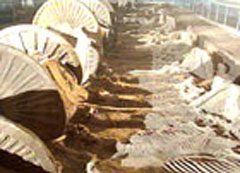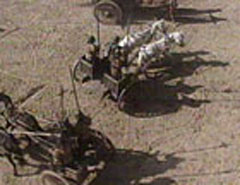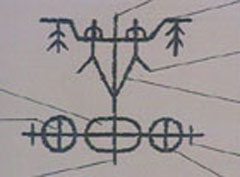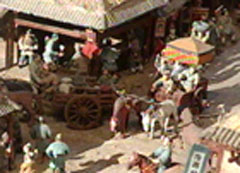 This wasteland of cobbles used to be a river in Shandong Province. The river dried up a long time ago, but we can still hear the then Zi River flowing swiftly. Even if we counted from the time when the State of Qi was founded, the river was there for over 3,000 years. This wasteland of cobbles used to be a river in Shandong Province. The river dried up a long time ago, but we can still hear the then Zi River flowing swiftly. Even if we counted from the time when the State of Qi was founded, the river was there for over 3,000 years.
These cobbles and gravels reflect the historical changes of the past 3,000 years. They also witnessed the splendor of the Qi capital Linzi.
When the cogon grass on the banks of the Zi River just turned green in 1964, a group of strangers came to Houliguan Village on the river’s east bank. They were members of the Linzi Cultural Relics Working Team under Shandong Provincial Culture Bureau. They were both excited and puzzled by the quiet open country. What on earth was buried under the site of the ancient city that was 3,000 years old?
They soon had the answer after a few months’ exploration and excavation. The unearthed potsherds and potteries conveyed this information: it was highly probable that here was an important site of Dawenkou Culture. However, the "cultural revolution" began when the archeological work was in full swing. As a result, the work had to be suspended.
In 1985, the Jinan-Qingdao Expressway would be built across the ruins here according to plan. Archeologists immediately designed pits for exploration.
At the east bank of the Zi River they found the big tomb. The tomb was about 35 meters long and 9 meters wide. The coffin and the body had rotten. As the tomb had been robbed before, few burial articles left.
According to the working diary of the archeologists, on the page dated April 16, 1990: There is a gray pit in the south. The soil is hard and gray. The pit is deep and has a line of silt.
The soil colors on the two sides were different. One was yellow, and the other was mixed. In accordance with the different soil colors, archeologists excavated layer by layer. The body of the cart gradually appeared, immediately followed by wheels.
 According to Wang Yongbo, a research fellow from Cultural Relics Section of Dept. of Culture of Shandong Province, the wheel is now round. But it wasn’t so round when we first got it out. Why? We didn’t know much at the time, so we kept scraping. It was just like a rat’s nest. After some excavation, we put the earth back. We wondered what it was. We probed, but we couldn’t see anything. So we scraped more. And it was still there after we scraped more. When we got it too thin, it was bad. When we measured the two ends, we found the other end had the same lever. That was the wheel, so we couldn’t scrape any more.
According to Wang Yongbo, a research fellow from Cultural Relics Section of Dept. of Culture of Shandong Province, the wheel is now round. But it wasn’t so round when we first got it out. Why? We didn’t know much at the time, so we kept scraping. It was just like a rat’s nest. After some excavation, we put the earth back. We wondered what it was. We probed, but we couldn’t see anything. So we scraped more. And it was still there after we scraped more. When we got it too thin, it was bad. When we measured the two ends, we found the other end had the same lever. That was the wheel, so we couldn’t scrape any more.
Having overcome the problems caused by the summer rain, Wang Yongbo led his colleagues in working in their work shed despite the high temperatures of over 40 degrees Celsius. Thanks to over four months of hard work, they finally excavated the No. 1 pit of carts and horses. The 30-meter-long pit had ten carts and 32 horses. Six of the carts were driven by six horses, and four by two horses. Next to the pit was the eight-meter-long No. 2 pit, in which six immolated horses were excavated.
“When the horses were first unearthed, there were horizontally arranged shells on them. The shells were sewn to the leather. The halters of the horses are like plum flowers; they are cross-shaped. Some of the flowers worn on horse heads are single-stringed just like pearls, others are cross-shaped, and still others are bronze. Different carts have different ornaments,” said Wang Yongbo.
In the Shandong area, either horses or carts were found buried with the dead. However, this was the first time to find both carts and horses buried with the dead. History seemed to be giving special favor to this generation of archeologists. The treasures that had been buried underground for several thousand years chose this moment to display the splendor of the State of Qi’s cart and horse culture in the Spring and Autumn Period. As this cart and horse pit provides a specific and visual basis for research in ancient Chinese carts, the State Bureau of Cultural Relics included it in the “top 10 archeological findings in China in 1990.”
On a sunny day, Wang Yongbo climbed up a seven-meter aluminum alloy ladder. He staggered and pressured the shutter of his camera. Wang Yongbo didn’t forget to have a picture of him with the cart and horse pit taken when he used his camera to reexamine the historical ruins. He thought that might be his last picture with the pit. At that time he was worried that if the expressway passed through the pit, the valuable carts and horses would have to be destroyed. So he traveled here and there for their protection.
It is because of the Jinan-Qingdao Expressway that archeologists excavated the cart and horse pit. Five meters under the roadbed is the cart and horse pit. These quiet and unruffled ancient carts and horses are now exposed to the noise of wheels moving swiftly. Unknowingly, history and reality are combined together for a chorus.
The China Museum of Ancient Carts, which was built on the basis of the cart and horse pit, is close to the ancient Zi River. Today the desolate Zi River still adds radiance to the modern expressway and the museum of ancient carts. This is by no means accidental; this is the continuation of the profound life of the Zi River that nourished the civilization of the State of Qi.
 Since these carts and horses were unearthed in 1990, archeologists and historians have never stopped their research in them. Their purpose is to find the orbit of development of ancient Chinese carts.
Since these carts and horses were unearthed in 1990, archeologists and historians have never stopped their research in them. Their purpose is to find the orbit of development of ancient Chinese carts.
Archeologists have found from these muddy ruins that the carts were mainly made of timber, rattan and leather. In the broken wheels, there is an ancient weapon called “dagger-axe.” These axes aroused the interest of archeologists. Since these 10 two-wheeled carts have weapons with them, were they used as war chariots in ancient times?
In the Spring and Autumn Period, battles were frequently fought. In addition to being used as a means of transportation and for the conveyance of heavy goods, carts were more often used in wars. At that time, the size of the army and the number of war chariots were an important basis for determining whether a state was strong. At the time a state was referred to as state with 1,000 or 10,000 chariots. These chariots were drawn by four horses.
On a morning of February 1046, King Wu of Zhou led his troops with 300 chariots in arriving at Muye. Dukes and princes also led their chariots to join him here. Over 4,000 chariots were arranged around King Wu. His enemy King Zhou of Shang also accumulated large numbers of chariots and arranged them in confrontation. It seems that over 10,000 chariots were involved in that battle.
Over 400 years later, chariots became the most important spoils of war. In the Battle of Chengpu in the Spring and Autumn Period, the State of Jin and the State of Chu involved more than 1,000 chariots. With over 700 chariots, the Jin troops defeated the Chu troops. Following the battle, the Jin troops presented to Zhou Tianzi over 100 Chu chariots they had captured. That was a big present over 2,600 years ago.
There are many etiquettes for chariots to go into battles. For example, sacrifices must be offered and different etiquettes must be performed before chariots were released into a battle. Chariots had strict requirements for battlefields that must be broad. So the loser had to change the direction of the banks between their fields to facilitate the movement of chariots. Crops also hampered the movement of chariots. At that time chariots were clumsy. There were many etiquettes concerning chariots. In addition, only people with higher ranks were allowed on chariots,” said Yang Hong, a research fellow from Institute of Archeology of Chinese Academy of Social Sciences.
Most chariots had rectangular cars. A car was usually good for three people to stand, with the driver being in the middle. Only the chariot for the king was exceptional. Because the king must be in the middle, the driver had to give up that position. But his position was still close to the middle, or his two hands would have difficulty controlling the four horses before him.
 “The one on the right side of the chariot was responsible for fighting the enemy with a long-handled weapon. The one on the left side took charge of shooting arrows. So when you fought in a battle on a chariot at that time, you had to target the right side of your chariot at the right side of the enemy chariot. It is just like present vehicles moving toward each other. You have to target the right side of your vehicle at the right side of the enemy vehicle. You cannot fight each other unless the two vehicles come together,” said Yang Hong.
“The one on the right side of the chariot was responsible for fighting the enemy with a long-handled weapon. The one on the left side took charge of shooting arrows. So when you fought in a battle on a chariot at that time, you had to target the right side of your chariot at the right side of the enemy chariot. It is just like present vehicles moving toward each other. You have to target the right side of your vehicle at the right side of the enemy vehicle. You cannot fight each other unless the two vehicles come together,” said Yang Hong.
In the Spring and Autumn Period, battles of chariots were fought in broad fields, with chariots being arranged horizontally. When fighting on chariots, it was difficult to use dagger-axes and swords efficiently. Only when two opposing chariots came close enough could dagger-axes be used to fight each other. That means only when the two chariots turned left simultaneously could attacks be launched from the right side of the chariot. This has been explained in the Book of Songs. With this rule of battle, the format would be disrupted in the first round of attacks. It was difficult to put the horse-drawn chariots back into their original format. Therefore, a battle of chariots in the Spring and Autumn Period usually came to an end within one day.
Although battles of chariots didn’t last long, they were unquestionably brutal. In his poem, Qu Yuan described the magnificence and fierceness of battles of chariots.
In 709 BC in the Eastern Zhou Dynasty, Duke Jin and Duke Yi fought each other. Jin’s troops pursued and attacked Duke Yi’s chariots. The horses drawing chariots were tripped and couldn’t move. All the officers and men on the chariots were taken captives. Later on, the states of Han, Zhao and Wei carved up the State of Jin, thus ushering the period of the Warring States. When they fought the cavalries of northern nomadic tribes, their “stupid” etiquettes for their chariots collapsed. After the Qin and Han dynasties, it was difficult to see any of these etiquette-controlled chariots.
There were 2,000 oxen-drawn chariots inserted among cavalries and infantrymen. The oxen were scared at the noise of fighting and the sounds of drums and horns. They ran violently in all directions. The format of the chariots was totally disrupted. Over 40,000 men were killed or injured. On hearing the news of Fang Guan’s defeat in Chang’an, Du Fu wrote a poem with a broken heart.
The wheels are more eye-catching than anything else in the cart and horse pit. Archeologists have made replicas of these carts that were produced 2,700 ago in the Spring and Autumn Period. By what specifications were these wood shafts, rattan wheels and leather cars produced?
Over 3,000 years ago in the Shang Dynasty, the pictographic character of “cart” preliminarily sketched the structure of a cart. These are the arms, and these are the shafts. This is the car. On the two sides of the car are the wheels.
Pictographic characters were based on real objects. Before the character “cart” appeared, carts had already been there. When on earth carts were first produced in China? It is said that at the beginning of the Chinese civilization, the Yellow Emperor made carts. He was therefore called Xuanyuan which means cart.
 Niu Yuqian is an artist with many years experience in designing properties in history plays. At the CCTV’S Zhuozhou Film and TV Base, he told us about the design and production of the carts in history plays.
Niu Yuqian is an artist with many years experience in designing properties in history plays. At the CCTV’S Zhuozhou Film and TV Base, he told us about the design and production of the carts in history plays.
In order to create proper properties for the full-length TV series The Romance of the Three Kingdoms, property designers consulted many ancient books. They often sought technical support from a book called Arts and Crafts Handbook.
Arts and Crafts Handbook is the oldest official book on arts and crafts China has now. Experts believe it was an official book of the State of Qi. The book deals with jade ware, potteries, ships, weapons, copper ware as well as architecture and water conservancy. It has very good discussion of how to make carts. It contains detailed descriptions of the materials, production and quality inspection.
In the antique storeroom of Linzi archeologists, we have found many models of cart parts. The grains of wood from the remains of carts are still visible. This shows in the Spring and Autumn Period the State of Qi had sophisticated cart-making skills. No wonder Arts and Crafts Handbook was written in the State of Qi.
Arts and Crafts Handbook tells us how to verify whether a wheel is balanced or not. You may hang a weight on the wheel. If the line is vertical, the spokes are even. You may also put the wheel into water to see if it floats evenly on the water. These simple and wise methods were still used many years later.
Soon after the State of Qi was founded, it worked out the program of following national customs, cutting down the number of formalities, developing business and industry and promoting freedom of speech. As a result, the talented people and goods of other states kept flowing to the State of Qi. At that time, Qi had a policy that is still believed to be open today. According to the policy, foreign businessmen should be given reception in accordance with the number of their carts. If they came with one cart, they would have free meals. Those with three carts would have free food and accommodation as well as free feed for their horses. If they came with five carts, besides what was provided to other businessmen, they would have five maids and bodyguards. This policy attracted large numbers of businessmen and made the city of Linzi prosperous.
Confucius might be in one of the carts. But he was here not for business, but for his great political ambitions.
At that time, people like Confucius must ride in a cart. The Analects of Confucius has this story: When Confucius’s disciple Yan Yuan died, his father Yan Lu suggested that Confucius sell his cart so as to buy a good coffin for Yan Yuan. Confucius turned him down, saying, “I am a scholar-official, so I shouldn’t walk.” This shows a cart is a symbol of a scholar-official.
|